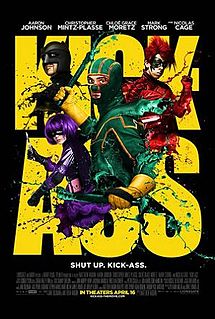In what ways does
our media product use, develop or challenge forms and conventions of real media
products?
 |
| The idea of a superhero film mixed with dark comedy and relationships was inspired by the film kick-ass, which also inspired the voice over. |
We wanted our film to seem like an independent
superhero action comedy. Because of this, our logos are made to look comic book
style and used parodies of superhero movie and companies. To immediately
introduce our audience to the comedic undertones in our film. From a black
screen we cut directly to a shot where the hero is thrown against the wall in a
mid-shot. This is to attract our audience and get them straight into the
action. It also breaks the traditional linear narrative structure by showing
the last battle before the opening titles. We give the impression that if we
continued the film; we would tell the audience how we got to the final battle
before showing it again along with its aftermath. The next shot is a mid-2-closeup shot in
which we are introduced to our villain, who grabs the hero. This is explaining
the first shot and introducing the stereotypical superhero conventions of
having the hero vs the villain. We then flow the motion of the villain tossing
the hero to the ground using the mid-2-closeup, then an aerial shot and finally
a low angle shot as the hero hits the ground. This shows traditional fight
scene conventions, which often feature short, quick cuts and show a single
sequence in three of four shots. We then go into an over the shoulder shot to
make the audience feel as though they are there watching this battle as it
happens and witnessing the brutal fight. Then we see the mid-2-shot as our hero
punches the villain into the wall. The action flows as the camera follows the
villain into the wall so the audience see all of what is happening in the
scene. As the villain lies on the floor, he is seen in a high-angle shot, which
is a conventional way of showing characters in a venerable position. The hero
than picks the villain up, spins him round and throws him into the wall in a
mid-2-shot. This is to show our protagonist and antagonist locked in battle and
is symbolic in most superhero films. In the next shot, we see the villain in a
wide shot on the floor as the hero sees if he is conscious, before the bad guys
kicks the good guy to the floor, revealing that he was playing possum. The
camera then follows the hero as he gets to his feet and is punched to the floor
by the villain. We wanted to use a convention from superhero fight scenes, in
which the villain almost wins before the hero surprises everyone and comes out
triumphant. Because of this the villain mainly dominates the fight scene. We
continue this theme with a very low angle shot (from the hero’s POV) of the
villain as the music becomes more menacing. A quick shot-reverse-shot shows the
hero, then back to the villain who goes for a punch. Just before he connects,
the screen cuts to black, the music stops and the hero narrates an
introduction. The idea of using the voice over comes from films like Spiderman, and Kick-Ass. Voice-Over is also useful because of the nonlinear
narrative structure, as the hero explains that he used to be a normal kid and
the story is about to tell you what changed. After this the titles themselves
run. Unlike superhero films, our title’s play out more like a teen drama film,
showing black and white still photographs with brightly coloured writing in
front of them. Breaking the conventions of the superhero movie shows our
audience that this is not a stereotypical superhero movie, and our photograph
idea coming, weirdly, from the film Mean
Girls. The black and white photos tell a story, much like the French surreal
sci-fi film La Jetée. Our photo story
tells us how the hero lost his only friend and takes it out on the nerdy kid
(breaks conventions because the nerdy kid becomes the villain, not the hero).
We used this form and story to convey the themes of loneliness (in both the
hero and villain), and we did not want this to be a straight forward, typical
superhero film and create a hybrid between the superhero film and teen dramas,
brutal action, dark comedy and tragicomedy.
 |
| Our idea of using non-linear narrative and the themes of lonlieness and isolation were influenced by Zack Snyder's film Watchmen. |
No comments:
Post a Comment